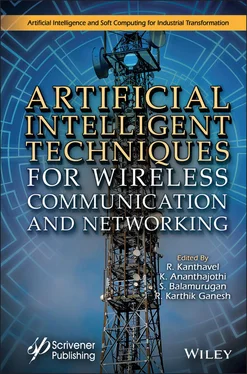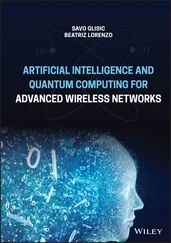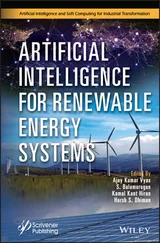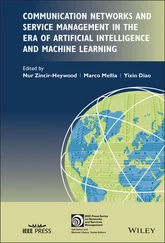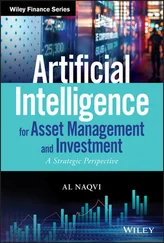Artificial Intelligent Techniques for Wireless Communication and Networking
Здесь есть возможность читать онлайн «Artificial Intelligent Techniques for Wireless Communication and Networking» — ознакомительный отрывок электронной книги совершенно бесплатно, а после прочтения отрывка купить полную версию. В некоторых случаях можно слушать аудио, скачать через торрент в формате fb2 и присутствует краткое содержание. Жанр: unrecognised, на английском языке. Описание произведения, (предисловие) а так же отзывы посетителей доступны на портале библиотеки ЛибКат.
- Название:Artificial Intelligent Techniques for Wireless Communication and Networking
- Автор:
- Жанр:
- Год:неизвестен
- ISBN:нет данных
- Рейтинг книги:5 / 5. Голосов: 1
-
Избранное:Добавить в избранное
- Отзывы:
-
Ваша оценка:
- 100
- 1
- 2
- 3
- 4
- 5
Artificial Intelligent Techniques for Wireless Communication and Networking: краткое содержание, описание и аннотация
Предлагаем к чтению аннотацию, описание, краткое содержание или предисловие (зависит от того, что написал сам автор книги «Artificial Intelligent Techniques for Wireless Communication and Networking»). Если вы не нашли необходимую информацию о книге — напишите в комментариях, мы постараемся отыскать её.
The 20 chapters address AI principles and techniques used in wireless communication and networking and outline their benefit, function, and future role in the field.
Audience
Artificial Intelligent Techniques for Wireless Communication and Networking — читать онлайн ознакомительный отрывок
Ниже представлен текст книги, разбитый по страницам. Система сохранения места последней прочитанной страницы, позволяет с удобством читать онлайн бесплатно книгу «Artificial Intelligent Techniques for Wireless Communication and Networking», без необходимости каждый раз заново искать на чём Вы остановились. Поставьте закладку, и сможете в любой момент перейти на страницу, на которой закончили чтение.
Интервал:
Закладка:
Table of Contents
1 Cover
2 Title Page
3 Copyright
4 Preface
5 1 Comprehensive and Self-Contained Introduction to Deep Reinforcement Learning 1.1 Introduction 1.2 Comprehensive Study 1.3 Deep Reinforcement Learning: Value-Based and Policy-Based Learning 1.4 Applications and Challenges of Applying Reinforcement Learning to Real-World 1.5 Conclusion References
6 2 Impact of AI in 5G Wireless Technologies and Communication Systems 2.1 Introduction 2.2 Integrated Services of AI in 5G and 5G in AI 2.3 Artificial Intelligence and 5G in the Industrial Space 2.4 Future Research and Challenges of Artificial Intelligence in Mobile Networks 2.5 Conclusion References
7 3 Artificial Intelligence Revolution in Logistics and Supply Chain Management 3.1 Introduction 3.2 Theory—AI in Logistics and Supply Chain Market 3.3 Factors to Propel Business Into the Future Harnessing Automation 3.4 Conclusion References
8 4 An Empirical Study of Crop Yield Prediction Using Reinforcement Learning 4.1 Introduction 4.2 An Overview of Reinforcement Learning in Agriculture 4.3 Reinforcement Learning Startups for Crop Prediction 4.4 Conclusion References
9 5 Cost Optimization for Inventory Management in Blockchain and Cloud 5.1 Introduction 5.2 Blockchain: The Future of Inventory Management 5.3 Cost Optimization for Blockchain Inventory Management in Cloud 5.4 Cost Reduction Strategies in Blockchain Inventory Management in Cloud 5.5 Conclusion References
10 6 Review of Deep Learning Architectures Used for Identification and Classification of Plant Leaf Diseases 6.1 Introduction 6.2 Literature Review 6.3 Proposed Idea 6.4 Reference Gap 6.5 Conclusion References
11 7 Generating Art and Music Using Deep Neural Networks 7.1 Introduction 7.2 Related Works 7.3 System Architecture 7.4 System Development 7.5 Algorithm-LSTM 7.6 Result 7.7 Conclusions References
12 8 Deep Learning Era for Future 6G Wireless Communications—Theory, Applications, and Challenges 8.1 Introduction 8.2 Study of Wireless Technology 8.3 Deep Learning Enabled 6G Wireless Communication 8.4 Applications and Future Research Directions Conclusion References
13 9 Robust Cooperative Spectrum Sensing Techniques for a Practical Framework Employing Cognitive Radios in 5G Networks 9.1 Introduction 9.2 Spectrum Sensing in Cognitive Radio Networks 9.3 Collaborative Spectrum Sensing for Opportunistic Access in Fading Environments 9.4 Cooperative Sensing Among Cognitive Radios 9.5 Cluster-Based Cooperative Spectrum Sensing for Cognitive Radio Systems 9.6 Spectrum Agile Radios: Utilization and Sensing Architectures 9.7 Some Fundamental Limits on Cognitive Radio 9.8 Cooperative Strategies and Capacity Theorems for Relay Networks 9.9 Research Challenges in Cooperative Communication 9.10 Conclusion References
14 10 Natural Language Processing 10.1 Introduction 10.2 Conclusions References
15 11 Class Level Multi-Feature Semantic Similarity-Based Efficient Multimedia Big Data Retrieval 11.1 Introduction 11.2 Literature Review 11.3 Class Level Semantic Similarity-Based Retrieval 11.4 Results and Discussion Conclusion References
16 12 Supervised Learning Approaches for Underwater Scalar Sensory Data Modeling With Diurnal Changes 12.1 Introduction 12.2 Literature Survey 12.3 Proposed Work 12.4 Results 12.5 Conclusion and Future Work References
17 13 Multi-Layer UAV Ad Hoc Network Architecture, Protocol and Simulation 13.1 Introduction 13.2 Background 13.3 Issues and Gap Identified 13.4 Main Focus of the Chapter 13.5 Mobility 13.6 Routing Protocol 13.7 High Altitude Platforms (HAPs) 13.8 Connectivity Graph Metrics 13.9 Aerial Vehicle Network Simulator (AVENs) 13.10 Conclusion References
18 14 Artificial Intelligence in Logistics and Supply Chain 14.1 Introduction to Logistics and Supply Chain 14.2 Recent Research Avenues in Supply Chain 14.3 Importance and Impact of AI 14.4 Research Gap of AI-Based Supply Chain References
19 15 Hereditary Factor-Based Multi-Featured Algorithm for Early Diabetes Detection Using Machine Learning 15.1 Introduction 15.2 Literature Review 15.3 Objectives of the Proposed System 15.4 Proposed System 15.5 HIVE and R as Evaluation Tools 15.6 Decision Trees 15.7 Results and Discussions 15.8 Conclusion References
20 16 Adaptive and Intelligent Opportunistic Routing Using Enhanced Feedback Mechanism 16.1 Introduction 16.2 Related Study 16.3 System Model 16.4 Experiments and Results 16.5 Conclusion References
21 17 Enabling Artificial Intelligence and Cyber Security in Smart Manufacturing 17.1 Introduction 17.2 New Development of Artificial Intelligence 17.3 Artificial Intelligence Facilitates the Development of Intelligent Manufacturing 17.4 Current Status and Problems of Green Manufacturing 17.5 Artificial Intelligence for Green Manufacturing 17.6 Detailed Description of Common Encryption Algorithms 17.7 Current and Future Works 17.8 Conclusion References
22 18 Deep Learning in 5G Networks 18.1 5G Networks 18.2 Artificial Intelligence and 5G Networks 18.3 Deep Learning in 5G Networks Conclusion References
23 19 EIDR Umpiring Security Models for Wireless Sensor Networks 19.1 Introduction 19.2 A Review of Various Routing Protocols 19.3 Scope of Chapter 19.4 Conclusions and Future Work References
24 20 Artificial Intelligence in Wireless Communication 20.1 Introduction 20.2 Artificial Intelligence: A Grand Jewel Mine 20.3 Wireless Communication: An Overview 20.4 Wireless Revolution 20.5 The Present Times 20.6 Artificial Intelligence in Wireless Communication 20.7 Artificial Neural Network 20.8 The Deployment of 5G 20.9 Looking Into the Features of 5G 20.10 AI and the Internet of Things (IoT) 20.11 Artificial Intelligence in Software-Defined Networks (SDN) 20.12 Artificial Intelligence in Network Function Virtualization 20.13 Conclusion References
25 Index
26 Also of Interest
27 End User License Agreement
List of Tables
1 Chapter 11Table 11.1 Experimental details.Table 11.2 Analysis on clustering accuracy vs no. of classes.Table 11.3 Performance analysis in retrieval accuracy vs no. of classes.Table 11.4 Performance on false classification ratio vs no. of classes.Table 11.5 Performance analysis on time complexity vs no. of classes.Table 11.6 Performance on clustering accuracy vs no. of terms/relations.Table 11.7 Performance analysis in retrieval accuracy vs no. of terms/relations.Table 11.8 Analysis on false classification ratio vs no. of terms/relations.Table 11.9 Performance analysis on time complexity vs no. of terms/relations.
2 Chapter 12Table 12.1 SeaOne temperature data considered during day time.Table 12.2 SeaOne temperature considered during night time.Table 12.3 SeaOne temperature data considered during day time.Table 12.4 SeaOne temperature considered during night time.Table 12.5 SeaOne temperature data considered during day time.Table 12.6 SeaOne temperature considered during night time.Table 12.7 SeaOne temperature data considered during day time.Table 12.8 SeaOne temperature considered during night time.Table 12.9 Network information in statistical analysis for sample-1.Table 12.10 Model summary for calculating relative errors in testing data.Table 12.11 Network information in statistical analysis for sample-1 at night.Table 12.12 Model summary for calculating relative errors in testing data at nig...Table 12.13 Network information in statistical analysis for sample-2.Table 12.14 Model summary for calculating relative errors in testing data at nig...Table 12.15 Case processing summary for sample 1 data obtained from Table 12.1.Table 12.16 ACF function for Table 12.1 data.Table 12.17 Case processing summary for sample 1 and Table 12.2 data.Table 12.18 ACF function for Table 12.2 data.Table 12.19 PACF function for Table 2 data.Table 12.20 Absorption loss in underwater environment for input of real time tem...Table 12.21 Transmission loss in underwater environment for input of real time t...
Читать дальшеИнтервал:
Закладка:
Похожие книги на «Artificial Intelligent Techniques for Wireless Communication and Networking»
Представляем Вашему вниманию похожие книги на «Artificial Intelligent Techniques for Wireless Communication and Networking» списком для выбора. Мы отобрали схожую по названию и смыслу литературу в надежде предоставить читателям больше вариантов отыскать новые, интересные, ещё непрочитанные произведения.
Обсуждение, отзывы о книге «Artificial Intelligent Techniques for Wireless Communication and Networking» и просто собственные мнения читателей. Оставьте ваши комментарии, напишите, что Вы думаете о произведении, его смысле или главных героях. Укажите что конкретно понравилось, а что нет, и почему Вы так считаете.
